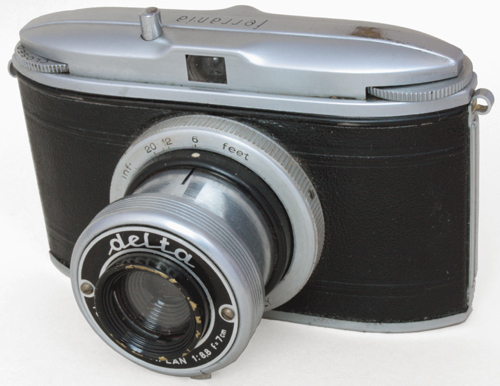Difference between revisions of "Ferrania Delta"
m (pic pool membership CP -> CW; rights) |
m (127) |
||
| Line 1: | Line 1: | ||
| − | {{ | + | {{127}} |
{{Flickr image | {{Flickr image | ||
| image_source=http://www.flickr.com/photos/awcam/3846454897/in/pool-camerawiki | | image_source=http://www.flickr.com/photos/awcam/3846454897/in/pool-camerawiki | ||
| image=http://farm3.static.flickr.com/2525/3846454897_14078398b3_o.jpg | | image=http://farm3.static.flickr.com/2525/3846454897_14078398b3_o.jpg | ||
| − | | image_align= | + | | image_align=left |
| image_text=Ferrania Delta | | image_text=Ferrania Delta | ||
|image_by=AWCam | |image_by=AWCam | ||
|image_rights=with permission | |image_rights=with permission | ||
| − | }} | + | }}{{brl}} |
The '''Ferrania Delta''' is a small cast metal camera for [[127 film]]. It was made in Italy by [[Ferrania]], c.1949<ref>{{McKeown}}, p.291</ref>. | The '''Ferrania Delta''' is a small cast metal camera for [[127 film]]. It was made in Italy by [[Ferrania]], c.1949<ref>{{McKeown}}, p.291</ref>. | ||
Revision as of 18:23, 5 November 2012
| German, French & Italian Cameras using 127 film | |||
| G e r m a n y |
3×4 | rigid | Dreivier | Futuro | Gewirette | Kolibri Parvola | Pupille | Ranca | Reporter | Puck |
| folding | Baby Ikonta | Baldi | Dolly | Goldi Gucki | Ingo | Korelle | Makinette Metharette | Perkeo | Vollenda | ||
| 4x4 | Navax | Paxina Electromatic | Rothlar | ||
| 4x6.5 | Bella | Billy | Bob | Dolly | Goldi Gucki | Korelle | Panta | Parvola Piccolette | Rio | Ultrix | ||
| TLR | see German TLRs | ||
| F r a n c e |
3×4 | rigid | Fotobaby | Lynx | Super-Boy |
| folding | Derby-Lux | Elax | ||
| pseudo TLR | Auteuil | Longchamp | ||
| 4×4 | rigid | Impera | Marly | Pari-Fex | Rubi-Fex | Top | |
| 4×6.5 | rigid | Photo-Magic | |
| I t a l y |
3x4 | Comet | Comet III | Cometa | Euralux Ibis | Maxima | Piccolo | Tanit | |
| 4x4 | Comet | Euralux | Ibis | ||
| 4x6.5 & other | Alfa | Delta | Relex | Rolet | Rondine | ||

|
| Ferrania Delta image by AWCam (Image rights) |
The Ferrania Delta is a small cast metal camera for 127 film. It was made in Italy by Ferrania, c.1949[1].
The Delta has a simple I/B everset shutter with a focusing lens on a collapsible lens tube. The focus is set by a ring on the body-end, or rear-end, of the tube, rather than the more usual control at the front. To open the camera, a latch which looks like the film advance wheel (but at the other end) is rotated, and the top-plate is removed from the shell. The film spool carrier is attached to the top plate; the lens tube is mounted on the body shell. Image format is 4x6.5cm, using a Biaplan 70mm f8.8 lens.